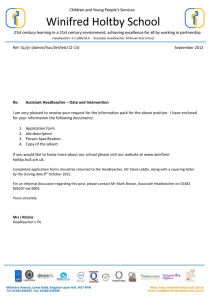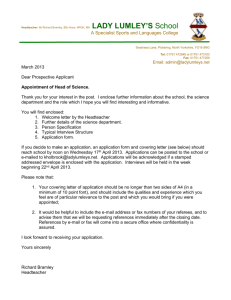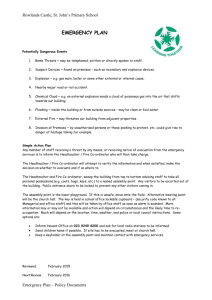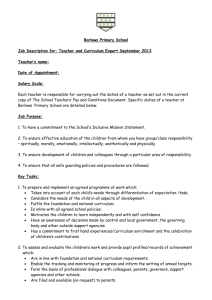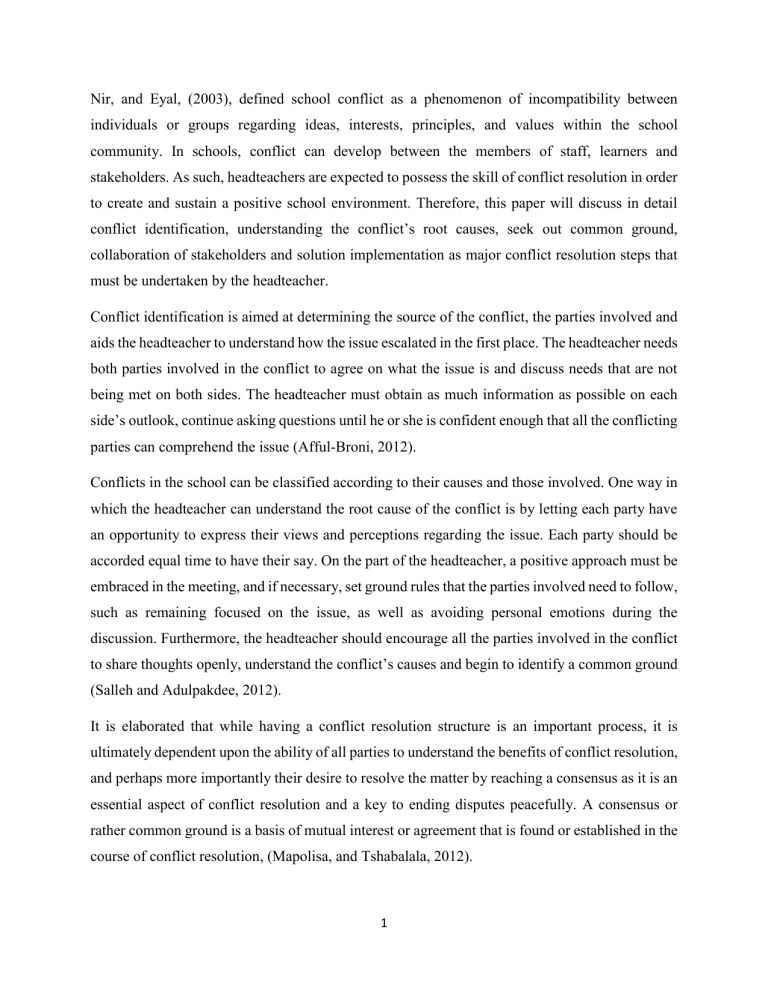
Nir, and Eyal, (2003), defined school conflict as a phenomenon of incompatibility between individuals or groups regarding ideas, interests, principles, and values within the school community. In schools, conflict can develop between the members of staff, learners and stakeholders. As such, headteachers are expected to possess the skill of conflict resolution in order to create and sustain a positive school environment. Therefore, this paper will discuss in detail conflict identification, understanding the conflict’s root causes, seek out common ground, collaboration of stakeholders and solution implementation as major conflict resolution steps that must be undertaken by the headteacher. Conflict identification is aimed at determining the source of the conflict, the parties involved and aids the headteacher to understand how the issue escalated in the first place. The headteacher needs both parties involved in the conflict to agree on what the issue is and discuss needs that are not being met on both sides. The headteacher must obtain as much information as possible on each side’s outlook, continue asking questions until he or she is confident enough that all the conflicting parties can comprehend the issue (Afful-Broni, 2012). Conflicts in the school can be classified according to their causes and those involved. One way in which the headteacher can understand the root cause of the conflict is by letting each party have an opportunity to express their views and perceptions regarding the issue. Each party should be accorded equal time to have their say. On the part of the headteacher, a positive approach must be embraced in the meeting, and if necessary, set ground rules that the parties involved need to follow, such as remaining focused on the issue, as well as avoiding personal emotions during the discussion. Furthermore, the headteacher should encourage all the parties involved in the conflict to share thoughts openly, understand the conflict’s causes and begin to identify a common ground (Salleh and Adulpakdee, 2012). It is elaborated that while having a conflict resolution structure is an important process, it is ultimately dependent upon the ability of all parties to understand the benefits of conflict resolution, and perhaps more importantly their desire to resolve the matter by reaching a consensus as it is an essential aspect of conflict resolution and a key to ending disputes peacefully. A consensus or rather common ground is a basis of mutual interest or agreement that is found or established in the course of conflict resolution, (Mapolisa, and Tshabalala, 2012). 1 To create a non-confrontational environment where everyone can freely express themselves, demonstrate mindful listening to each other, show respectful disagreement and finding a common ground; the headteacher can utilize the civil discourse approach which enables the parties involved in the conflict to have a productive exchange of ideas and express their views without rancor. Each one of them should honestly present their thoughts to find a common ground without downplaying or overstating their ideas. Civil discourse lays down the stepping stone to align different visions and find common ground faster, (Leskes, 2013; Schwab, 1956). If the headteacher continues to have trouble finding common ground or it is a conflict that requires involvement of a third party, He or she may need to collaborate with a stakeholder who can help out with the navigation of the situation. Robbins (2017), describes a stakeholder as anyone who is impacted, either directly or indirectly, by what happens within a school. Stakeholders in education include students, parents, educators, policy-makers and the business community. Hence, collaborating with stakeholders in conflict resolution can mean having an objective party in the room that can help you defuse tension, get your points across, and identify areas of agreement. After reaching a consensus and a solution is agreed upon, there is need for effective implementation to ensure that the conflict has been resolved successfully. Some of the conflict resolution strategies that can be initiated are as follows: One of the strategies that can be implemented when the discomfort of confrontation exceeds the potential reward of resolution of the conflict is avoiding. Avoiding is when people just ignore or withdraw from the conflict. If the matter is not that important, ignoring the situation and moving from the conflict is a wise choice as it saves energy and peace of mind. Some problems or conflicts resolve themselves if given time. If not solved, you can approach to solve it with a fresh perspective (Ghaffar, 2009). Competing is used by people who go into a conflict planning to win and this usually happens when the parties involved in the conflict are assertive and not cooperative. This method is characterized by the assumption that one side wins and everyone else loses (Girard, & Koch, 1996). It doesn’t allow room for diverse perspectives into a well-informed total picture. Competing is a forcing strategy in which relationships should be sacrificed sometimes at least for a certain time until the misunderstanding clears. 2 Accommodating, also known as smoothing, is a strategy where one party gives in to the wishes or demands of another. In this scenario, the parties are being cooperative but not assertive. Accommodating appears to be a gracious way to give in when one figures out he or she has been wrong about an argument. This strategy allows the parties to resolve a conflict in the short-term while working on the long-term solutions (Ramani and Zhimin, 2010). Collaborating is the method used when people involved in the conflict are both assertive and cooperative. It involves working with the other party to find a mutually agreeable solution to a problem. It is known as a win-win strategy. According to Henkin, Cistone, and Dee (2000), “party may learn to allow the other part to make a contribution with the possibility of co-creating a shared solution that both of them can support.” Collaboration is by far the best win-win strategy. It involves efforts, commitment and excellent empathizing skills. When collaborating, relationships are maintained well with mutual understanding. This strategy of collaboration produces satisfying solutions despite requiring plenty of time and energy (Ikoya and Akinseinde, 2009). Last yet not the least, compromising which is also referred to as reconciling or lose-lose strategy. This is where the conflict associated parties are partially assertive and cooperative. The concept is that everyone gives up a little bit of what they want, and no one gets everything they want. The perception of the best outcome when working by compromise is that which “splits the difference.” Compromise is perceived as being fair, even if no one is particularly happy with the final outcome. The parties come to understand that certain goals are not as important as the relationship itself. Thus, they tend to give up on certain mundane tasks. Making priorities by realizing when to fight for their cause and when to compromise, in order to get to an agreement and achieve harmony (Wachira, 2011). In conclusion, it is inevitable to state that the ability to resolve conflict is often seen as a leadership trait. Graham (1991), denotes that organizational leaders are responsible for creating a conducive work environment that enables people to thrive. Thereby, in a school environment, the head teacher as a leader is seen as a person who can identify conflicts, acknowledge different opinions and build a consensus, working hand in hand with both the internal and external stakeholders, as well as employing the above stated five conflict resolution strategies, which are valuable to the school. 3 REFERENCES Afful-Broni, A. (2012). Conflict management in Ghanaian schools: A case study of the role of leadership of Winneba Senior High School. International Journal of Educational Planning and Administration, 2(2), 65-76. Ghaffar, A. (2009). Conflict in Schools: Its Causes & Management Strategies. Journal of Managerial Sciences, 3(2). Girard, K., & Koch, S. J. (1996). Conflict Resolution in the schools: A Manual for Educators. Jossey-Bass Publishers, 350 Sansome Street, San Francisco, CA 94101. Graham, J. W. (1991). Servant-leadership in organizations: Inspirational and moral. The leadership quarterly, 2(2), 105-119. Henkin, A. B., Cistone, P. J., & Dee, J. R. (2000). Conflict management strategies of principals in site‐based managed schools. Journal of Educational Administration, 38(2), 142-158. Ikoya, P. O., & Akinseinde, S. I. (2009). Variability pattern in conflict management strategies among school administrators of secondary schools in Nigeria. Journal of Social Sciences, 20(3), 223-230. Leskes, A. (2013). A plea for civil discourse: Needed, the academy’s leadership. Liberal Education, 99(4), 44-51. Mapolisa, T., & Tshabalala, T. (2012). Research Article an Investigation into the Causes of conflict management. 1-6. Nir, A. E., & Eyal, O. (2003). School‐based management and the role conflict of the school superintendent. Journal of Educational Administration. Ramani, K., & Zhimin, L. (2010). A survey on conflict resolution mechanisms in public secondary schools: A case of Nairobi province, Kenya. Educational research and reviews, 5(5), 242. Salleh, M. J., & Adulpakdee, A. (2012). Causes of conflict and effective methods to conflict management at Islamic secondary schools in Yala, Thailand. International Interdisciplinary Journal of Education, 1(1), 15-22. 4 Schwab, J. J. (1956). Science and civil discourse: The uses of diversity. The Journal of General Education, 9(3), 132-143.Science and civil discourse: The uses of diversity. The Journal of General Education, 9(3), 132-143. Stakeholders and conflict management: Corporate perspectives on collaborative approaches. In Unfolding Stakeholder Thinking 2 (pp. 162-179). Routledge. Wachira, T. (2011). Influence of headteachers' conflict management styles on teachers' job satisfaction in public primary schools, Gilgil District, Kenya (Doctoral dissertation, University of Nairobi, Kenya). 5
